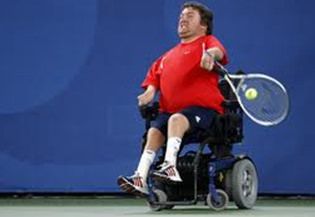Technical Considerations

In principle, the fundamentals of racquet work and ball control are the same for wheelchair players as A/B’s (Able Bodied players). The main difference is that wheelchair players have less time to execute strokes. The combination of mobility limitations and the fact that the racquet hand is engaged in maneuvering the chair makes it difficult to prepare early.
The following are some specific technical points to consider regarding the three stroke families:
GROUNDSTROKES Grips: All grips for tennis also work for wheelchair players. Coaches should guide players into grips that would work best for each individual. One additional grip required is the grip to hold the wheel and the racquet. Each player must find a grip that can maximize the contact point on the wheel and allow for a quick transition to hitting.
Balance & Stability: It is acceptable for the player (right-handed) to grab the left side of the chair for balance while performing groundstrokes. On forehands, a player may lean on both knees with the left forearm. For extra rotation, a player can pull back on the left wheel on forehands.
SERVE & OVERHEAD Toss: Higher injury level players will not be able to toss the ball directly over or behind the head. Impact point: On overheads, the player must maneuver to impact the ball slightly in front of the chair. Taking the ball on the bounce, or chasing it down and hitting ‘over the shoulder’ are other options. With 4- wheel chairs (chairs with an additional wheel in the rear) a short backward roll is also possible. Balance & Stability: A technique that can improve stability is to grab the left side of the chair or pull back on the left wheel immediately after the serve toss.
VOLLEYS Wheelchair players do not come to the net often because of lateral mobility limitations. However, players should be encouraged to attack the net to finish points.
